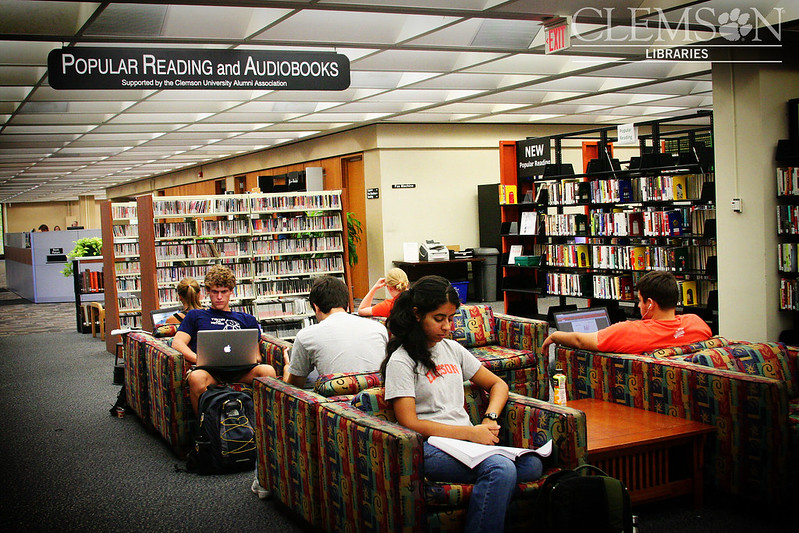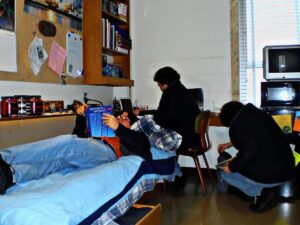Chapter 5 Study Skills
5.1 Learning Environment
Now that you’ve worked up an attitude for success and are feeling motivated, it’s time to get organized. You need to organize both your space and your time. This is an essential part of good study skills. It starts with a good studying environment.
Tips for Effective, Individual Study Spaces

Most students more or less take what they can get when it comes to study areas. Schools usually offer a variety of nooks and crannies for students to hunker down and get their assignments done. The school library is a good (and quiet) place. Many common areas elsewhere on campus have tables, chairs, couches, and lounges to accommodate learners. But most students end up doing the majority of their out-of-class work at home.
Home environments may be limited in terms of providing all of the recommended aspects of a good study space, but many of the recommendations can be either implemented or adapted from what a student has on hand or what can be improvised no matter what environment they are living in. Elements conducive to a more effective study/homework experience include such things as good lighting, ample supplies, comfortable seating, adequate space, organization, and personalizing the study area to add a touch of inspiration and motivation.
Space is important for many reasons—some obvious, some less so. People’s moods, attitudes, and levels of work productivity change in different spaces. Learning to use space to your own advantage helps get you off to a good start in your studies. Here are a few of the ways space matters:
- Everyone needs their own space. This may seem simple, but everyone needs some physical area, regardless of size, that is really their own—even if it’s only a small part of a shared space. Within your own space, you generally feel more secure and in control.
- Physical space reinforces habits. For example, using your bed primarily for sleeping makes it easier to fall asleep there than elsewhere. It is a bad choice for studying as you are in the habit of relaxing and going to sleep there, so it’s harder to stay alert and focused.
- Different places create different moods. While this may seem obvious, students don’t always use places to their best advantage. One place may be bright and full of energy, with happy students passing through and enjoying themselves—a place that puts you in a good mood. But that may actually make it more difficult to concentrate on your studying. Yet the opposite—a totally quiet, austere place devoid of color and sound and pleasant decorations—can be just as unproductive if it makes you associate studying with something unpleasant. You will need to discover what space works best for you and then let that space reinforce good study habits.
Use Space to Your Advantage and to Avoid Distractions
Begin by analyzing your needs, preferences, and past problems with places for studying. Where do you usually study? What are the best things about that place for studying? What distractions are most likely to occur there?
The goal is to find, or create, the best place for studying, and then to use it regularly so that studying there becomes a good habit.
- Choose a place you can associate with studying. Make sure it’s not a place already associated with other activities (eating, watching television, sleeping, etc.). Over time, the more often you study in this space, the stronger will be its association with studying, so that eventually you’ll be completely focused as soon as you reach that place and begin.
- Your study area should be available whenever you need it. If you want to use your home, apartment, or dorm room but you never know if another person may be there and possibly distract you, then it’s probably better to look for another place, such as a study lounge or an area in the library. Look for locations open at the hours when you may be studying. You may also need two study spaces—one in or near where you live, another on campus. Sometimes you have to make do depending on circumstances. For example, you have an hour free between two classes, and your regular study areas are too far away to use for only an hour. Look for a convenient study place nearby such as a cafeteria or student lounge.

- Your study space should meet your study needs. An open desk or table surface usually works best for writing, and you’ll tire quickly if you try to write notes sitting in an easy chair (which might also make you sleepy). You need good light for reading, to avoid tiring from eyestrain. If you use a laptop for writing notes or reading and researching, you need a power outlet so you don’t have to stop when your battery runs out.
- Your study space should meet your psychological needs. Some students may need total silence with absolutely no visual distractions; they may find a perfect study carrel hidden away on the fifth floor in the library. Other students may be unable to concentrate for long without looking up from reading and momentarily letting their eyes move over a pleasant scene. Some students may find it easier to stay motivated when surrounded by other students also studying; they may find an open space in the library or a study lounge with many tables spread out over an area. Experiment to find the setting that works best for you—and remember that the more often you use this same space, the more comfortable and effective your studying will become.
- You may need the support of others to maintain your study space. Students living at home, whether with a spouse and children or with their parents, often need the support of family members to maintain an effective study space. The kitchen table probably isn’t best if others pass by frequently. Be creative, if necessary, and set up a card table in a quiet corner of your bedroom or elsewhere to avoid interruptions. Put a “do not disturb” sign on your door.
- Keep your space organized and free of distractions. You want to prevent sudden impulses to neaten up the area (when you should be studying), do laundry, wash dishes, and so on. Unplug a nearby telephone, turn off your cell phone, and use your computer only as needed for studying. If your email or message program pops up a notice every time an email or message arrives, turn off your notifications, turn off your Wi-Fi, or detach the network cable to prevent those intrusions.
- Plan for breaks. Everyone needs to take a break occasionally when studying. Think about the space you’re in and how to use it when you need a break. If in your home, stop and do a few exercises to get your blood flowing. If in the library, take a walk up a couple flights of stairs and around the stacks before returning to your study area.
- Prepare for human interruptions. Even if you hide in the library to study, there’s a chance a friend may happen by. At home with family members or in a dorm room or common space, the odds increase greatly. Have a plan ready in case someone pops in and asks you to join them in some fun activity. Know when you plan to finish your studying so that you can make a plan for later—or for tomorrow at a set time.
The Distractions of Technology
Multi-tasking is the term commonly used for being engaged in two or more different activities at the same time, usually referring to activities using devices such as cell phones, smartphones, computers, and so on. Many people claim to be able to do as many as four or five things simultaneously, such as writing an email while responding to an instant message (IM) and reading a tweet, all while watching a video on their computer monitor or talking on the phone. Many people who have grown up with computers consider this kind of multi-tasking a normal way to get things done, including studying. Even people in business sometimes speak of multi-tasking as an essential component of today’s fast-paced world.
Video: “Why the Human Brain Can’t Multitask” (length 2:39)
It is true that some things can be attended to while you’re doing something else, such as checking e-mail while you watch television news—but only when none of those things demands your full attention. You can concentrate 80 percent on the email, for example, while 20 percent of your attention is listening for something on the news that catches your attention. Then you turn to the television for a minute, watch that segment, and go back to the email. But you’re not actually watching the television at the same time that you’re composing the email—you’re rapidly going back and forth. In reality, the mind can focus only on one thing at any given moment. Even things that don’t require much thinking are severely impacted by multi-tasking, such as driving while talking on a cell phone or texting. An astonishing number of people end up in the emergency room from just trying to walk down the sidewalk while texting; it is a common occurrence for people to walk into a pole or parked car while multi-tasking.
“Okay,” you might be thinking, “why should it matter if I write my paper first and then answer emails or do them back and forth at the same time?” It actually takes you longer to do two or more things at the same time than if you do them separately—at least with anything that you actually have to focus on, such as studying. That’s true because each time you go back to studying after looking away to a message or tweet, it takes time for your mind to shift gears to get back to where you were. Every time your attention shifts, add up some more “downtime”—and pretty soon it’s evident that multi-tasking is costing you a lot more time than you think. And that’s assuming that your mind does fully shift back to where you were every time, without losing your train of thought or forgetting an important detail. It doesn’t always.
The other problem with multi-tasking is the effect it can have on the attention span—and even on how the brain works. Research has shown that in people who constantly shift their attention from one thing to another in short bursts, the brain forms patterns that make it more difficult to keep sustained attention on any one thing. So when you really do need to concentrate for a while on one thing, such as when studying for a big test, it becomes more difficult to do even if you’re not multi-tasking at that time. It’s as if your mind makes a habit of wandering from one thing to another and then can’t stop.
So stay away from multi-tasking whenever you have something important to do, like studying. If it’s already a habit for you, don’t let it become worse. Manipulate your study space to prevent the temptations altogether. Turn your computer off—or shut down email and messaging programs if you need the computer for studying. Turn your cell phone off—if you just tell yourself not to answer it but still glance at it each time to see who sent or left a message, you’re still losing your studying momentum and have to start over again. For those who are really addicted to technology (you know who you are!), go to the library and don’t take your laptop or cell phone.
In Chapter 7 Time Management, effective time management strategies are discussed, including scheduling breaks in your study periods, usually for a few minutes every hour. If you’re really hooked on checking for messages, plan to do that at scheduled times.
What about listening to music while studying? Some don’t consider that multi-tasking, and many students say they can listen to music without it affecting their studying. Studies are inconclusive about the positive or negative effects of music on people’s ability to concentrate, probably because so many different factors are involved. But there’s a huge difference between listening to your favourite CD and spontaneously singing along with some of the songs and enjoying soft background music that enhances your study space the same way as good lighting and pleasant decor. Some people can study better with low-volume instrumental music that relaxes them and does not intrude on their thinking, while others can concentrate only in silence. And some are so used to being immersed in music and the sounds of life that they find total silence more distracting—such people can often study well in places where people are moving around. The key thing is to be honest with yourself: if you’re actively listening to music while you’re studying, then you’re likely not studying as well as you could be. It will take you longer and lead to less successful results.
Family and Roommate Issues

Sometimes going to the library or elsewhere is not practical for studying, and you have to find a way to cope in a shared space.
Part of the solution is time management. Agree with others on certain times that will be reserved for studying; agree to keep the place quiet, not to have guests visiting, and to prevent other distractions. These arrangements can be made with a roommate, spouse, and older children. If there are younger children in your household and you have child-care responsibility, it’s usually more complicated. You may have to schedule your studying during their nap time or find quiet activities for them to enjoy while you study. Try to spend some time with your kids before you study, so they don’t feel like you’re ignoring them.
The key is to plan ahead. You don’t want to find yourself, the night before an exam, in a place that offers no space for studying.
Finally, accept that sometimes you’ll just have to say no. If your roommate or a friend often tries to engage you in conversation or suggests doing something else when you need to study, just say no. Learn to be firm but polite as you explain that you just really have to get your work done first. Students who live at home may also have to learn how to say no to parents or family members—just be sure to explain the importance of the studying you need to do. Remember, you can’t be everything to everyone all the time.
Key Takeaways
- Where you study can have a huge impact on the effectiveness of your study efforts. Choose and organize your space to your advantage.
- How you control your study space can help you prevent distractions, especially those caused by other people or your personal technology.
- Attempting to multi-task while studying diminishes the quality of your study time and results in a loss of time.
- Control your study space to prevent or manage potential interruptions from family members or roommates.
Exercise: Learning Environment
- For each of the following statements, circle T for true or F for false:
Your bed is usually a good place to study if you can keep the room quiet. T F To study well, use the most drab, boring place you can find. T F Having a designated study area means you can set up an organized space with all of your resources that provides a consistent place to study. T F To maintain a clear focus while studying, limit the time you spend checking for email and text messages to every ten minutes or so. Put your cell phone on vibrate mode and keep it in your pocket where you can more easily ignore it. T F It’s OK to have the television or radio on while you study as long as you don’t give it your full attention. T F The key to avoiding interruptions and distractions from family members or roommates is to plan ahead for when and where you’ll study. T F - Class discussion or online forum discussion: Share stories about distractions caused by roommates and others that you and other students have experienced. Brainstorm together how to handle similar situations next time they arise.
Exercise: Learning Environment – Home Study Area
- Describe your current study area at home—the good, the bad, and the ugly. Be thorough.
- List as many ways you think you can realistically improve, change, or start from scratch your study area. Remember, you might not have the advantage of a whole room, or even a corner of a room, but there are still some changes you can make to create a more effective study environment.
References
Levitin, D. (2015, January 18). Why the modern world is bad for your brain. The Guardian. Retrieved from https://www.theguardian.com/science/2015/jan/18/modern-world-bad-for-brain-daniel-j-levitin-organized-mind-information-overload
Doraiswamy, S. (2012, October 8). Does music help you study? Retrieved from http://www.mindthesciencegap.org/2012/10/08/does-music-help-you-study/.
Text Attributions
- This chapter was adapted from “Organizing Your Space” in University Success by N. Mahoney, B. Klassen, and M. D’Eon. Adapted by Mary Shier. CC BY-NC-SA.
- The first two paragraphs after the “Tips for Effective, Individual Study Spaces” heading are from “The Basics of Study Skills” in Blueprint for Success in College and Career by Dave Dillon. CC BY.
Video Attributions
- “Why the Human Brain Can’t Multitask” by FORA.tv. Standard YouTube Licence.
Media Attributions
- Cluttered Desk © OpenClipartVictors is licensed under a Public Domain license
- Students Study in 4 West © Clemson University Library is licensed under a CC BY-NC (Attribution NonCommercial) license
- Multitasking © Benton Greene is licensed under a CC BY (Attribution) license

